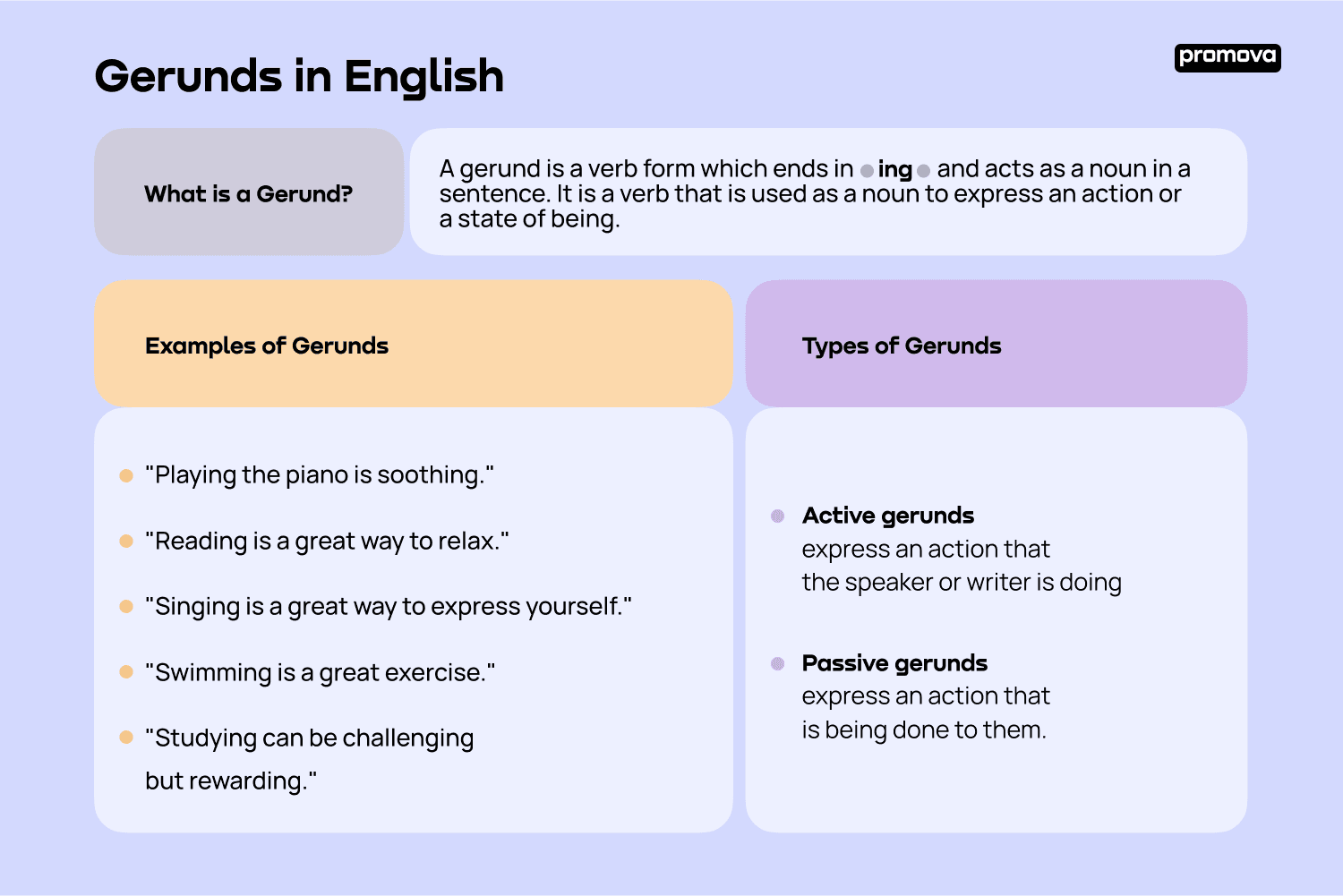Gerunds in English
Contents
Gerunds are an important part of English grammar and understanding them can help you become a more proficient speaker and writer. In this reference, we'll take a close look at gerunds, including what they are, their meaning, examples, types, and how to use them in everyday speech. Let's start learning!
What is a Gerund?
A gerund is a verb form which ends in "ing" and acts as a noun in a sentence. It is a verb that is used as a noun to express an action or a state of being. For example, "running" is a gerund because it expresses an action. Gerunds can be used as the subject, object, or complement in a sentence. For example, in the sentence "I enjoy running," "running" is the gerund and it is used as the complement.
The most basic gerund definition is that it is a verb form that acts as a noun. However, to really understand gerunds, we need to look at their meaning and examples.

Understanding Gerund Meaning
A gerund is used as a noun in sentences. It helps express an action or a state of being. To understand the meaning of a gerund, it's important to look at the context of the sentence in which it is used. For example, in the sentence "I enjoy running," the gerund "running" is used as the complement, which means that the speaker enjoys performing the action of running.
Gerunds can also express a state of being. For example, in the sentence "Being a teacher is rewarding," the gerund "being" is used as the subject, which means that the speaker finds it rewarding to be a teacher.
Examples of Gerunds
Now that we understand the meaning of a gerund, let's look at some examples of gerunds in sentences.
- "Playing the piano is soothing."
- "Reading is a great way to relax."
- "Singing is a great way to express yourself."
- "Swimming is a great exercise."
- "Studying can be challenging but rewarding."
These examples show how gerunds can be used as the subject, object, or complement in your sentence.
Types of Gerunds
There are two types of gerunds: active and passive.
Active gerunds express an action that the speaker or writer is doing, while Passive gerunds express an action that is being done to them.
For example, in the sentence "I enjoy running," the gerund "running" is an active gerund because the speaker is actively performing the action. On the other hand, in the sentence "I was surprised by the sudden noise," the gerund "noise" is a passive gerund because the speaker is being affected by the action.
Gerunds vs. Other Parts of Speech
It's important to understand the difference between gerunds and other parts of speech. Gerunds are used as nouns, while other parts of speech like verbs, adjectives, and adverbs are used to modify nouns. For example, in the sentence "I enjoy playing," the gerund "playing" is used as the complement and it expresses an action. On the other hand, the verb "enjoy" is used to modify the gerund "playing."
Gerunds can also be distinguished from other parts of speech by their spelling. Verbs end in "ing" while nouns, adjectives, and adverbs end in "ed," "ly," or other suffixes. For example, the verb "looking" is a gerund while the adjective "surprised" and the adverb "suddenly" are not gerunds.
4
Advantages of Using Gerunds
Gerunds can be used to express a variety of ideas and emotions. They can be used to express actions, states of being, and feelings. They can also be used to express complex ideas simply. For example, the sentence "I love driving" expresses the speaker's feelings about driving in just three words.
Gerunds can also be used to add variety and interest to a sentence. They can be used to express emotions that would otherwise be difficult to express. For example, the sentence "I was surprised by the sudden noise" expresses the speaker's surprise succinctly and interestingly.
Gerunds in Everyday Speech
Gerunds are used in everyday speech to express actions, states of being, and emotions. They can be used to add interest and variety to conversations and make them more engaging.
Gerunds can also be used to express complex ideas. For example, the sentence "Reading is a great way to relax" expresses the idea that reading can help us relax without using too many words.
List of Gerunds
Here is a list of 30 common gerunds in English:
- Running
- Swimming
- Singing
- Dancing
- Writing
- Playing
- Working
- Studying
- Eating
- Shopping
- Cooking
- Cleaning
- Laughing
- Smiling
- Driving
- Walking
- Talking
- Listening
- Riding
- Crying
- Thinking
- Climbing
- Jumping
- Flying
- Skiing
- Painting
- Drawing
- Sleeping
- Gardening
- Breaking
These are just a few examples of gerunds in English. Any verb can become a gerund, give it a shot!
Summary
Gerunds are a form of verb that act as a noun in a sentence. They express an action or a state of being and can be used as the subject, object, or complement in a sentence. There are two types of gerunds: active and passive. Gerunds can be used to add variety and express complex ideas.
Now that you understand gerunds, you can use them to speak more naturally in English. Check out more handy references below to improve your skills!
Comments